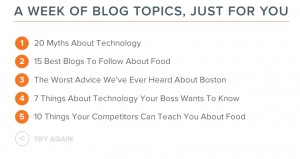Four Things Your Boss Doesn’t Know About Content
January 23, 2014

As part of HubSpot’s blog in an hour contest, this post was generated beginning at 12PM today and published at 12:35PM (longer than the 11 minutes I promised Laura). The topic was selected and tweaked by using the Blog Topic Generator they provided. I do this for a living, so I don’t think this was a fair fight for others who don’t get paid to blog. That said, I better stop spouting off and get to the meat of this post. THOUGH, my spouting off is exactly one of the things your boss doesn’t know about social media and content.
We all work. We all have bosses. Whether that boss is a scientist or a burger flipper, they probably don’t have enough knowledge in their noggin to help them create scintillating content. You know the stuff. The content that gets clicks, eyeballs, discussions and even sales. For content to work, it must be created strategically.
Let’s jump right into the list of four things your boss doesn’t know about content because if you waste much more time here reading about how content works, you might be out of a job. Or the NSA will track your movements to this blog and then will put you on some list and maybe call you a social media guru or scientist – whichever is worse.
1 – Content isn’t anything new.
Your boss gets all excited that content is something that arrived in 2006 with the advent of social media tools. Sorry, social media tools include smoke signals, the Telex, postcards and even fax machines that still use curly paper. A social media tool is something that carries content from one person to one person or from one person to many people. That’s it. Nothing new about this except that people in suits and C-level executives (sometimes the same crowd) latched onto the phrase content as if it was something they had to rush after like a bucket of gold. It is, but the companies who are winning today (and were winning yesterday) were already creating great content.
Simply put, communicate clearly. Then bottle that communication. That is content.
2 – Viral Content is something you cannot create.
For something to go viral, it has to catch fire organically. You cannot designate something as viral content and then hope to ride it to the end zone. Calling something a viral video is a sure way to get seven views for that video. It’s also akin to giving yourself a nickname. Viral can’t be planned, it just happens.
The next time a client or a manager says, “what we need is to create a viral video”, you should run far, run fast, and update your LinkedIn profile.
3 – Content CAN lead to sales.
Some companies see content as a waste of time. Even if they are putting out flyers, sales letters, whitepapers and other forms of content on a regular basis. Their confusion is that content must be posted on the Internet or shared via social media like Twitter and Facebook. Content – OF ANY KIND – can lead to sales because good content leads to customer connections which can lead to affinity which can lead to top-of-mind awareness which can lead to buying decision-making which can lead to sales. But the process isn’t one that takes 300-1400 words and one blog post. It requires a commitment and some dedication.
If you want your content to draw people to give you money, you must exhibit that same commitment to sharing value. Make your content valuable and people will often find value in your company.
4 – The is NO recipe for the right kind of content.
A blog post does not have to be 1000 words and have three photos. A tweet doesn’t have to always have a link in it. A video doesn’t have to be in focus. There are very few rules to creating perfect content. The sad thing – for folks whose gravy train comes from the marketing budget – is that the same effort must be put into content no matter what vehicle you use to share it. A tweet might be like a billboard in terms of reinforcing awareness. A video might be like a TV ad in terms of creating brand affinity and motivating buyers. Regardless, nobody (not even me or a social media scientist) can tell you what content works and why. Timing is still one of the biggest factors to good content finding quality audiences and turning into positive ROI. And as long as Google keeps changing their SEO formulas, the best content is going to be the stuff your audience actually finds valuable.
Write, shoot, create the stuff your audience wants (and you only know this by asking your audience and stepping into their shoes) and you will be closer to creating content that is right for them. There are no magic bullets, but you can get close.
That’s it. I welcome your thoughts, rants, recipes and links in the comments. If you want to hire me to create content for you – or talk to you about the right content for your audiences – contact me.
Thanks for reading.






